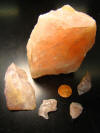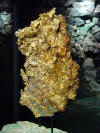|
Common Rock-Forming Minerals |
|
Rocks are composed of a relatively
small number of minerals, the
rock-forming minerals.
Eight minerals make up the vast
majority of igneous rocks. The eight
include the two feldspars
plagioclase
and orthoclase
(potassium feldspar),
quartz,
the micas muscovite
and biotite,
the amphibole mineral
hornblende, the
pyroxene mineral augite,
and the green mineral
olivine. Sedimentary
rocks most often are composed of
clay, quartz
and calcite,
but may include
dolomite, gypsum and
halite
(rock salt). Metamorphic rocks are
chemically complex; they often
include the igneous minerals listed
above as well as
chlorite, epidote, actinolite,
garnet, serpentine,
and many others. |
 |
 |
 |
 |
 |
 |
| The
feldspars are the most common
mineral family in the crust of the
Earth (about half of all minerals).
This is a sample of potassium
feldspar (orthoclase). |
Potassium
feldspar (orthoclase) is often
pinkish in color and displays the
property of cleavage,
the tendency to break along flat
planes. It is harder than glass. |
While
cooling, two related forms of
feldspar essentially try to grow in
the same space and intermingle. The
resulting irregular layers are
called perthite
intergrowths. |
Potassium
feldspar (orthoclase). Perthite
intergrowths on the left sample. The
mineral has two directions of
cleavage that meet at right angles. |
Plagioclase
is the other important form of
feldspar. It is chemically complex,
with a sodium- and calcium-rich
varieties. Plagioclase is harder
than glass. |
Plagioclase
can be white or gray in color, and
has two directions of cleavage at
close to right angles. |
 |
 |
 |
 |
 |
 |
| Plagioclase
has a unique pattern of
crystallization called twinning that
leads to a property of parallel
lines called striations. |
Striations
on plagioclase look like record
grooves, and can be seen in very
small crystals. It is a diagnostic
property of plagioclase |
Plagioclase
with striations. |
Plagioclase
with striations. |
One form of
plagioclase, called labradorite, is
gray in color but displays an
interesting property called "labradorescence"
(see next photo). |
"Labradorescence"
is an intense play of color from
some angles. "Black Granite" used in
countertops is not granite, but is a
rock called gabbro that contains
lots of plagioclase. |
 |
 |
 |
 |
 |
 |
| Quartz is
the most familiar of the
rock-forming minerals and makes up
around a quarter of the Earth's
crust |
Quartz is
the hardest of the common minerals,
at 7 on the Moh's Scale (out of 10).
They crystallize in the hexagonal
class. |
Quartz
samples displaying conchoidal
(glass-like) fracture. Quartz does
not possess the property of
cleavage. |
Quartz often
is found in beautiful clusters of
well-formed crystals. |
Traces of
impurities can impart bright colors
to quartz. Iron oxide or other
substances are responsible for the
intense purple of amethyst quartz. |
Rose quartz
has trace amounts of manganese that
give it the unique color/ |
 |
 |
 |
 |
 |
 |
| Rose quartz
displays conchoidal fracture, the
glasslike rounded smooth surfaces. |
Smoky quartz
forms when clear crystals are
irradiated. Samples can be
artificially produced through the
use of x-rays. |
Smoky
quartz crystals |
Rutilated
quartz, a quartz crystal containing
long fibrous crystals of rutile, a
titanium oxide. |
Another
important rock-forming mineral is
olivine, seen here as a chunk of
dunite, a rock composed almost
entirely of olivine |
Olivine
crystals in a xenolith within
basalt. These chunks of rock within
the basalt are pieces of the earth's
mantle, the layer underlying the
crust. |
 |
|
|
|
|
|
| Olivine is
also known as the semi-precious
gemstone peridot. It can be
faceted or polished, as above. |
|
|
|
|
|
| |
|
|
|
|
|
| |
|
|
|
|
|
| |
|
|
|
|
|
| |
|
|
|
|
|
|
|
|
Other Minerals |
|
Although the minerals shown below
are generally rare, they are
important to society as a source of
metals and other industrial
materials, and as gemstones. |
 |
 |
 |
 |
|
|
| The gold
nugget at the Ironstone Winery in
California's Mother Lode. The nugget
was found in 1992 at the Sonora Mine
and weighs 44 lbs. |
A gold
nugget at the California State
Mineral Museum in Mariposa,
California. |
The Fricot
Nugget, on display at the California
State Mineral Museum in Mariposa,
California. The nugget weighs nearly
14 lbs. |
Detail of
the Fricot Nugget, on display at the
California State Mineral Museum in
Mariposa, California. The nugget
weighs nearly 14 lbs. |
|
|
| |
|
|
|
|
|
| |
|
|
|
|
|
| |
|
|
|
|
|
| |
|
|
|
|
|
| |
|
|
|
|
|
| |
|
|
|
|
|

